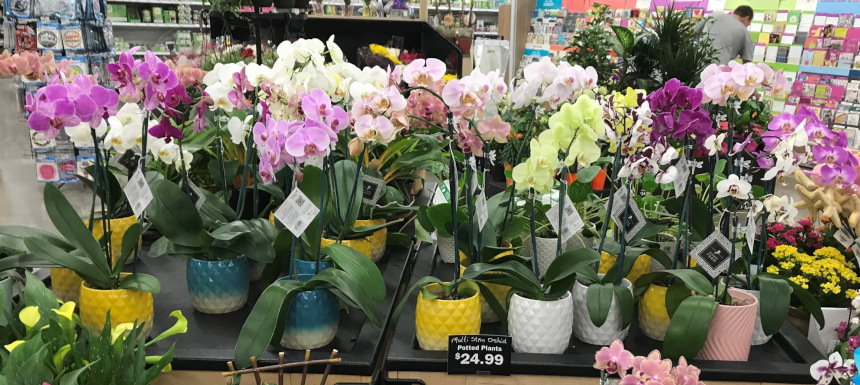How to Keep an Orchid Alive
“The worst instructions ever perpetrated on orchid growers is the suggestion to water with ice cubes,” says Ron McHatton, the Chief Science and Education Officer at the American Orchid Society. “These are tropical plants. Do you want your feet in ice water?”
Of course, not all orchids are tropical, but the ones McHatton is recommending for you — a novice orchid owner — are. They are called Phalaenopsis, and they are an “easy” houseplant to grow.
That might be disheartening to read if you’ve ever killed one, but McHatton says you only need some better advice to keep a moth orchid thriving in your home. Step one: save the ice for your martinis.
Orchids are one of the most diverse families of flowering plants in the world. Their unique blooms beguile expert growers and casual plant lovers alike. The Phalaenopsis family boasts more than 60 species, though you’ll have to do some hunting to find more than a handful that are commonly cultivated.
The most important factor in orchid care might be the place you choose to purchase your plant. Those colorful blooms greeting you at the entrance of your favorite big-box department store might be enticing, but McHatton says you’re better off going with a local orchid dealer or nursery. A knowledgeable grower can answer questions about your plant and give you practical advice for growing it in whatever conditions you face. It’s unlikely that the cashier at Target will harbor the same expertise.

Furthermore, McHatton says, many orchids sold at big-box stores are doomed from the start: “I’ve seen lots of plants in stores where the die has already been cast. The plants already have a root-rotting fungus before they’re even purchased.” The reason for this, sometimes, is that the plants are sold growing in sphagnum moss. While this is an acceptable substrate for orchids, it holds water longer than others. This gives the plants more moisture for the long periods of time they could be sitting on a shelf, and that could cause problems. Before buying an orchid, inspect the roots to make sure they look healthy and firm.
And once you get the thing home? McHatton says, “don’t stick them in a shady corner and overwater them.” Put your orchid in a bright spot by a window, and allow it to dry out before each watering.
It isn’t exactly as straightforward as it sounds, though. There isn’t a one-size-fits-all watering regimen for Phalaenopsis orchids, because it depends largely on the kind of pot and substrate you’re using, not to mention the humidity of the room. Sphagnum moss dries out the slowest, then coconut chips, bark, and clay pellets. For the vessel, a plastic pot will take longer to dry out, then terra cotta, and a slotted clay pot or a basket will dry the fastest. The combination that you use should match your watering habits as well as the environment you can offer.
An orchid might be okay in a slotted pot with coconut chips in a moderately bright, humid bathroom, but the same plant will have a hard time sitting over a heating vent in winter. McHatton refers to a person’s ability to pick up on a plant’s needs as a “plant sense,” and he says it works the same way with many houseplants. If you can keep it alive long enough to see it thrive while you’re treating it well, you’ll know what it wants.
Repotting plants is an inevitable stage of houseplant care, but McHatton says newbie growers need not repot their orchid right away. It damages the roots and stresses the plant during an already stressful transition from one place to another. When you do repot, McHatton says to rinse out coconut chips and bark first to remove any remaining salts from the manufacturer.
Watering an orchid plant is just as straightforward as watering most other houseplants. Run water over the roots for 30 seconds or so to flush out salts from your tap water, and leave it to mostly dry out before repeating. The problem with using ice cubes is that the salts from trickling water compound on the plant’s roots and substrate without being fully rinsed away.
Generally, orchids prefer an environment with higher humidity. Spritzing them with a spray bottle is fine, but it won’t create any lasting humidity. If you feel your orchid is drying out a little too quickly, it might benefit from some nearby plant friends. Ferns and peace lilies surrounding the plant will keep the air around the orchid moist, particularly if you water them often. As a last resort, you can set the orchid pot in a tray of water that will moisten the pot and immediate air without wetting the roots.
Do you feel as though you’ve mastered Phalaenopsis orchids, and you want something a little more challenging? McHatton says the next steps are Lady’s Slippers and Cattleyas, two genuses that require slightly more light and stringent watering routines, but offer bloom shapes and sizes that differ from the Phalaenopsis genus. He warns against going wild if you’re struck with plant fever, though. “We get so enamored by the plant that we buy everything we see and then we try to figure out how to grow it,” McHatton says. “It’s much easier to try to grow the plants that are better suited to the conditions you can provide.”
Ron McHatton hosts a monthly webinar on orchid care on the American Orchid Society website.
Featured Image: Natalie Board on Shutterstock